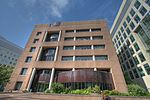Ragon Institute
Phillip T. and Susan M. Ragon Institute is a medical institute founded in 2009 at the Massachusetts General Hospital (MGH) by the funding from founder and CEO of InterSystems Phillip Ragon and his wife Susan Ragon to find vaccines for diseases of the immune system, particularly HIV/AIDS. The institute includes scientists from Harvard University, the Massachusetts Institute of Technology (MIT) and the MGH, a level I trauma center which is the largest teaching hospital affiliated with Harvard Medical School. The Phillip T. and Susan M. Ragon Institute, or the Ragon Institute of MGH, MIT and Harvard, was officially established in February 2009 with a dual mission: to contribute to the accelerated discovery of an HIV/AIDS vaccine and subsequently to establish itself as a world leader in the collaborative study of immunology.
Excerpt from the Wikipedia article Ragon Institute (License: CC BY-SA 3.0, Authors).Ragon Institute
Technology Square, Cambridge Cambridgeport
Geographical coordinates (GPS) Address Nearby Places Show on map
Geographical coordinates (GPS)
| Latitude | Longitude |
|---|---|
| N 42.364 ° | E -71.092 ° |
Address
400 Technology Square
Technology Square 400
02139 Cambridge, Cambridgeport
Massachusetts, United States
Open on Google Maps








